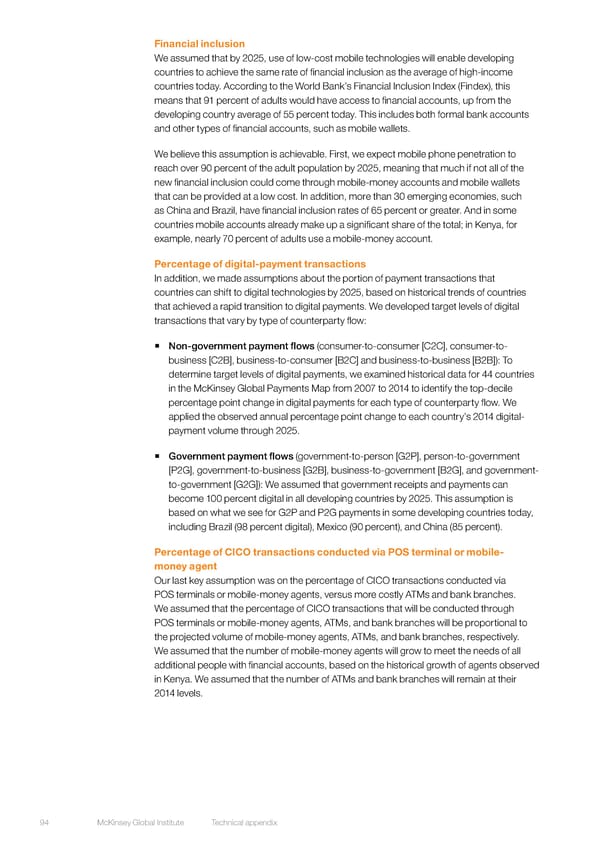Financial inclusion We assumed that by 2025, use of low-cost mobile technologies will enable developing countries to achieve the same rate of financial inclusion as the average of high-income countries today. According to the World Bank’s Financial Inclusion Index (Findex), this means that 91 percent of adults would have access to financial accounts, up from the developing country average of 55 percent today. This includes both formal bank accounts and other types of financial accounts, such as mobile wallets. We believe this assumption is achievable. First, we expect mobile phone penetration to reach over 90 percent of the adult population by 2025, meaning that much if not all of the new financial inclusion could come through mobile-money accounts and mobile wallets that can be provided at a low cost. In addition, more than 30 emerging economies, such as China and Brazil, have financial inclusion rates of 65 percent or greater. And in some countries mobile accounts already make up a significant share of the total; in Kenya, for example, nearly 70 percent of adults use a mobile-money account. Percentage of digital-payment transactions In addition, we made assumptions about the portion of payment transactions that countries can shift to digital technologies by 2025, based on historical trends of countries that achieved a rapid transition to digital payments. We developed target levels of digital transactions that vary by type of counterparty flow: ƒ Non-government payment flows (consumer-to-consumer [C2C], consumer-to- business [C2B], business-to-consumer [B2C] and business-to-business [B2B]): To determine target levels of digital payments, we examined historical data for 44 countries in the McKinsey Global Payments Map from 2007 to 2014 to identify the top-decile percentage point change in digital payments for each type of counterparty flow. We applied the observed annual percentage point change to each country’s 2014 digital- payment volume through 2025. ƒ Government payment flows (government-to-person [G2P], person-to-government [P2G], government-to-business [G2B], business-to-government [B2G], and government- to-government [G2G]): We assumed that government receipts and payments can become 100 percent digital in all developing countries by 2025. This assumption is based on what we see for G2P and P2G payments in some developing countries today, including Brazil (98 percent digital), Mexico (90 percent), and China (85 percent). Percentage of CICO transactions conducted via POS terminal or mobile- money agent Our last key assumption was on the percentage of CICO transactions conducted via POS terminals or mobile-money agents, versus more costly ATMs and bank branches. We assumed that the percentage of CICO transactions that will be conducted through POS terminals or mobile-money agents, ATMs, and bank branches will be proportional to the projected volume of mobile-money agents, ATMs, and bank branches, respectively. We assumed that the number of mobile-money agents will grow to meet the needs of all additional people with financial accounts, based on the historical growth of agents observed in Kenya. We assumed that the number of ATMs and bank branches will remain at their 2014 levels. 94 McKinsey Global Institute Technical appendix
 DIGITAL FINANCE FOR ALL Page 111 Page 113
DIGITAL FINANCE FOR ALL Page 111 Page 113